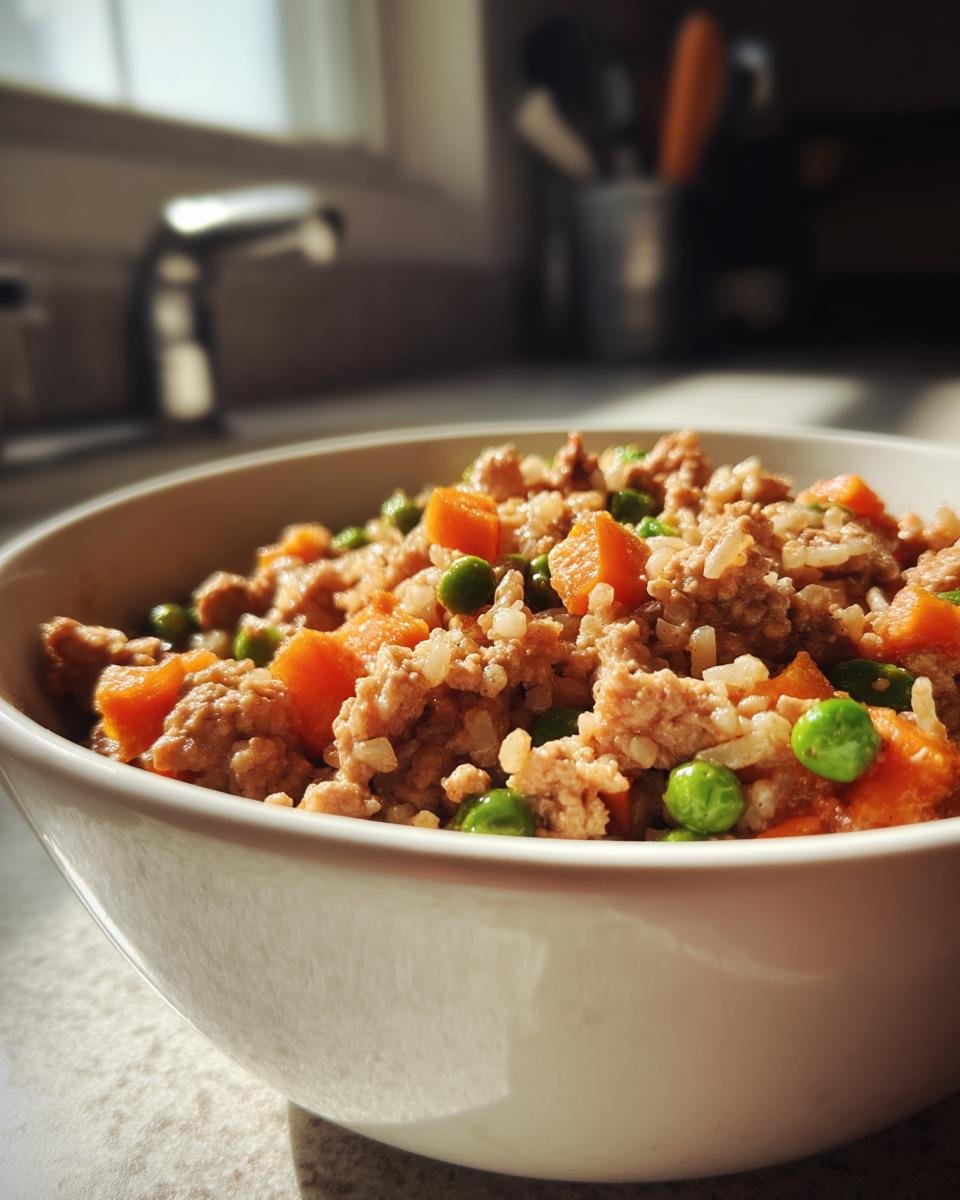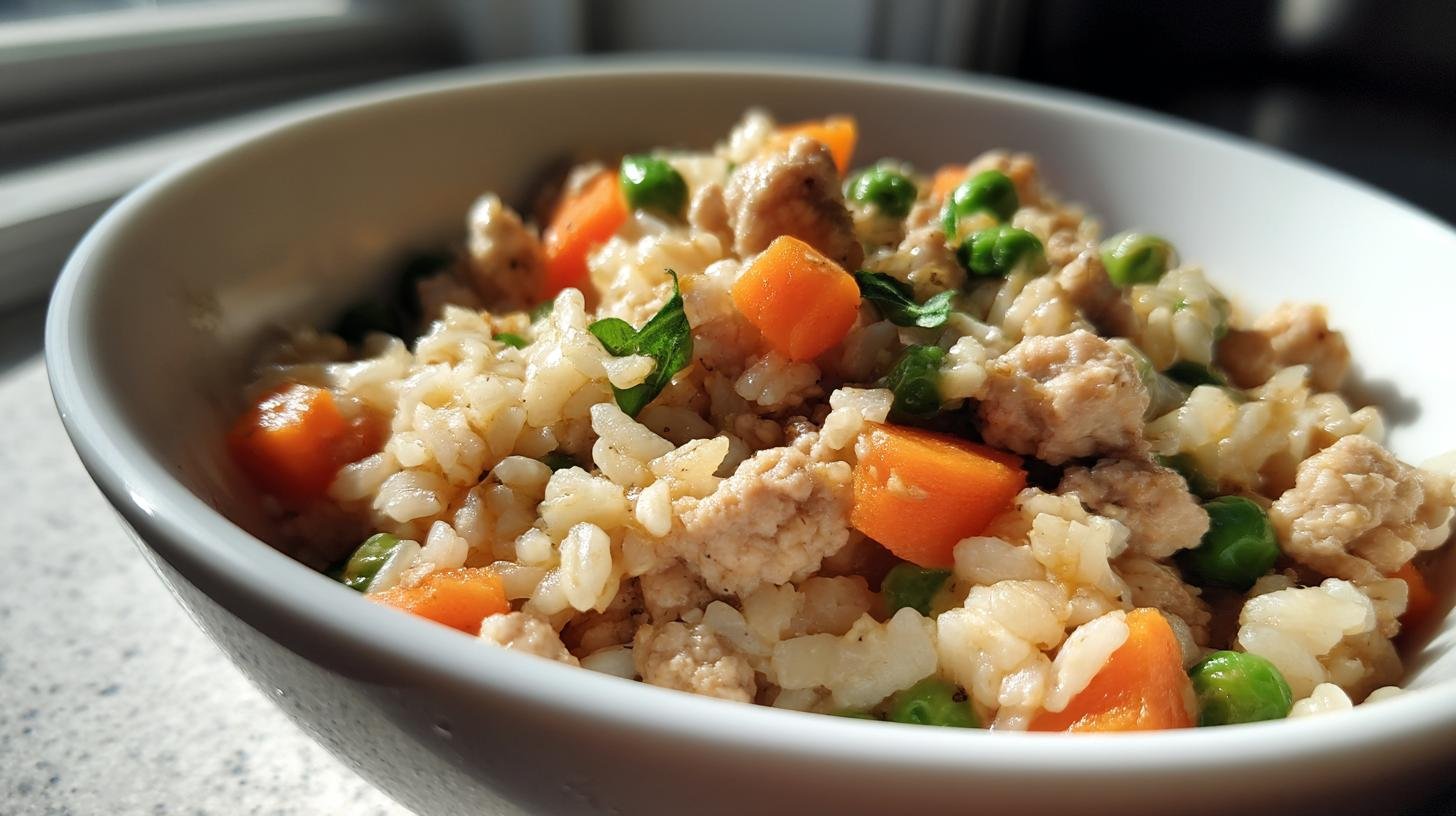Remember that panicked feeling when your new puppy turns up their nose at dinner? I sure do. When my golden retriever Maple refused every kibble brand I tried, my kitchen became a canine nutrition lab. After three failed attempts and one very hungry pup, I called Dr. Simmons – the vet who’d cared for my childhood dogs – and begged for help. That late-night phone call sparked my decade-long journey creating vet-approved puppy food recipes that actually make tails wag.
What started as scribbled notes on vet clinic letterhead (complete with gravy stains from an overexcited Maple) became my mission. Over 10 years developing balanced meals with veterinary nutritionists, I’ve learned one truth: growing puppies need more than just calories. They require precise ratios of protein, calcium, and digestible carbs – elements store-bought foods often get wrong for individual pups.
This recipe isn’t just another homemade dog food list. It’s the result of countless consultations with Dr. Simmons’ team, lab-tested nutrient analyses, and Maple’s enthusiastic taste tests (her “puppy eyes” game became legendary). We’ve balanced lean proteins with bone-building calcium carbonate and gut-friendly fibers – all while keeping that fresh-cooked aroma that makes puppies dance in anticipation. Because let’s be real – no amount of nutritional perfection matters if your furball won’t eat it.
Why This Vet-Approved Puppy Food Recipe Will Become Your Go-To
Let’s be real – Pinterest is full of questionable dog food hacks. What makes this vet-approved puppy food recipe different? Three things I’ve obsessed over since Maple’s picky eater days:
- 🐾 No guesswork safety: Every ingredient passed my vet’s “nope test” for toxic foods
- 🐾 Growth-perfect balance: That sneaky teaspoon of calcium carbonate? It’s what makes Dr. Simmons nod approvingly
- 🐾 Weeknight easy: Uses the same pots you’d cook your own dinner in (just don’t mix up the lids!)
3 Key Benefits for Growing Puppies
1. Bone-building magic: Puppies need 3x more calcium than adults during growth spurts. The ground turkey gives lean protein for muscles, while that calcium carbonate powder (don’t skip it!) mimics the bone content they’d get in the wild. I learned this the hard way when Maple’s X-ray showed weaker joints – never again.
2. Gentle on tiny tummies: Steamed carrots and peas break down easier than raw veggies. Dr. Simmons always reminds me: “Puppy intestines aren’t food processors!” The olive oil adds just enough fat without causing the dreaded “puppy pancake butt” (you know what I mean).
3. Allergy armor: No chicken, beef, or wheat – the usual suspects in food sensitivities. When my neighbor’s Lab had hives from store food, we swapped to this turkey-based mix. Three weeks later? Zoomies returned, redness gone. The relief was REAL.

The 3 Tools You’ll Actually Use (No Fancy Gadgets!)
Here’s the beautiful part – you probably own everything already. My go-to trio after years of weekly puppy meal prep:
- Your trusty skillet: That non-stick pan you use for eggs? Perfect for browning turkey without sticking. Just no garlic residue! (Maple once licked a “seasoned” pan – lesson learned.)
- Basic rice cooker: Don’t own one? A saucepan works, but I’m team “set it and forget it” when prepping puppy meals at 6 AM.
- Glass storage containers: Plastic absorbs odors – trust me, you don’t want salmon-scented Tupperware. These stack neatly in the fridge between feedings.
That’s it! No specialty gear needed. The rice cooker’s my MVP – keeps grains fluffy without babysitting. Pro tip: Label containers with feeding dates. Puppy portions change faster than their paw size!
Vet-Approved Ingredients List
Let’s talk ingredients – and why precision matters more than you’d think. After Dr. Simmons rejected my first batch for using “about a cup” of carrots, I learned puppy nutrition requires lab-level accuracy. Here’s exactly what you need:
- 1 lb lean ground turkey (90/10 fat ratio): Not 85/15. That extra 5% fat difference? It’s the line between perfect energy and puppy diarrhea city. Trust me on this.
- 1 cup packed finely chopped carrots: “Packed” means press them down in the measuring cup – puppies need that fiber, but their jaws can’t handle big chunks.
- 1 tsp calcium carbonate powder: Not liquid, not crushed eggshells. This exact form mimics what’s in veterinary supplements. Found mine in the baking aisle!
And a hard lesson: “Some vegetables” nearly got me in trouble. Dr. Simmons once spotted my “whatever’s in the fridge” veg mix – turns out zucchini can cause gas in certain breeds. Stick to the peas and carrots combo we’ve tested. Your pup’s tummy will thank you.
Step-by-Step Vet-Approved Puppy Food Instructions
Let’s get cooking! Follow these steps like you’re prepping for a tiny furry food critic (because you are). And hey – no sneaking bites! This smells way too good, but it’s all for the pup.
- Brown that turkey right: Crumble 1 lb lean ground turkey into your skillet on medium heat. No oil needed – the 10% fat is perfect. Stir like you’re making scrambled eggs! Done when zero pink remains (7-8 mins). Pro tip: Let it sizzle without stirring for 1 minute first – creates tasty browned bits puppies adore.
- Rice ritual: Rinse 1 cup brown rice until water runs clear (prevents mush). Add to rice cooker with 4 cups water. Hit start! No cooker? Simmer covered in a pot for 18 mins. Fluff with fork – should be tender but not sticky.
- Veggie victory: Chop carrots into pea-sized pieces (no choking hazards!). Steam in basket over 1” boiling water 6-8 mins. Peas go in last 2 mins. Mash slightly with fork – helps digestion. Watch: Overcooked veggies lose nutrients faster than a puppy loses attention!
- The big mix: Combine everything in that big salad bowl you never use. Drizzle 1 tbsp olive oil and sprinkle calcium carbonate. Stir like you’re folding cupcake batter – gentle but thorough. Taste test? Nope! Human tongues ≠ puppy palates.
- Cool it, chef: Spread mixture on baking sheet. Let sit 20 mins – should feel lukewarm, not hot. I learned this after Maple dove face-first into a warm batch… let’s just say melted whiskers aren’t a good look.
Cooking Proteins Safely
Browning turkey isn’t rocket science, but puppies need it just so. Medium heat is key – high temps create dry, tough bits that tiny jaws hate. Break up clumps constantly with a wooden spoon (metal scratches pans!). Look for even golden-brown color without dark spots. Drain? Only if there’s visible grease pooling – most should’ve cooked off. Saved the drippings once for gravy… Dr. Simmons still teases me about that “cheat day” recipe!
Preparing Puppy-Friendly Vegetables
Steaming > boiling, always. Those vibrant orange carrots? They’ll lose half their vitamin A if submerged! I use a collapsible metal steamer – fits any pot. Carrots go in first since they’re harder, then peas get a quick 2-minute spa treatment. Mash peas gently against the side of the bowl with a fork. Surprise benefit? Releases natural thickeners that help bind the food. Your pup gets maximum nutrition, minimal tummy trouble. Win-win!
Critical step: Cool completely before serving. I test by pressing a bit to my wrist – if it feels warmer than my skin, wait 10 more mins. Puppy mouths are sensitive! Storing warm food also breeds bacteria faster than rabbits… you’ve been warned.

Vet-Approved Ingredient Notes & Substitutions
Let’s talk swaps – because I know you’ll ask! While this vet-approved puppy food recipe works best as written, here’s what I’ve tested (and what made Dr. Simmons side-eye me):
Turkey → Chicken: Okay in a pinch, but use ground breast only. Thigh meat’s higher fat content once gave Maple the runs for days. Lesson learned: Always drain excess grease and consult your vet first – some pups develop poultry sensitivities out of nowhere.
Peas → Green beans: Fine if your pup turns up their nose at peas. Steam until mushy and chop extra small. But steer clear of canned beans – that sodium content? Yikes. Fresh or frozen only, please.
Brown rice → Quinoa: My holistic vet friend allows this for gluten-sensitive pups. Rinse thoroughly to remove bitter saponins. But heads up – it’s pricier and cooks faster than rice. Set a timer!
Never substitute the calcium carbonate unless your vet says so. I once tried crushed eggshells during a supply shortage – big mistake. The calcium wasn’t bioavailable, and Maple’s next checkup showed deficient levels. Now I keep a backup jar in my spice rack!
When in doubt? Snap a pic of your swap idea and text your vet. Mine responds faster to food questions than I do to my mom’s calls!
Storing and Reheating Vet-Approved Puppy Food
Remember that time I stored a batch in plastic takeout containers? Big mistake. By day two, the smell could’ve qualified as biological warfare. Here’s how to keep your vet-approved puppy food fresh without assaulting nostrils:
Fridge rule: Glass containers only, tightly sealed. They’ll keep 3 days max – I write dates in dry-erase marker right on the lid. Layer portions between parchment paper so you’re not chiseling frozen blocks later.
Freezer hack: Spread cooled food 1” thick in ziplock bags, press flat, and freeze. Breaks easily into pup-sized pieces! Lasts 30 days, but let’s be real – your growing furball will demolish it faster. Thaw overnight in fridge (counter thawing breeds bacteria faster than puppies find mischief!).
Reheating pro tip: 10 seconds in microwave, then stir thoroughly. Test on your wrist – if it’s warmer than my skin, let it sit. I learned this after Maple licked a steaming spoon and did her “hot potato” dance!
Vet-Approved Puppy Food Nutrition Information
Let’s geek out on the numbers! Here’s the breakdown per ½ cup serving (because yes, I weigh every batch):
| Nutrient | Per Serving |
|---|---|
| Calories | 200 |
| Protein | 12g |
| Fat | 8g |
| Carbs | 22g |
| Fiber | 3g |
| Sugar | 2g |
| Sodium | 50mg |
| Cholesterol | 40mg |
Note: Calculated using specific brands of ground turkey and organic veggies. Actual values may vary slightly – your carrot’s sweetness or rice’s starch content can shift numbers a smidge. Always consult your vet for breed-specific needs!
Tips for Perfect Vet-Approved Puppy Food
After 10 years of perfecting vet-approved puppy food recipes (and one very opinionated golden retriever), here’s my cheat sheet for puppy meal prep success:
- Mash those peas like you mean it: A quick fork smash breaks down the skins – makes digestion easier than a naptime belly rub. Maple used to leave whole peas in her bowl until I started this trick!
- Weekly weigh-ins: Puppies grow faster than zucchini plants! Use a kitchen scale every Sunday – adjust portions as they gain. That ½ cup serving? Might become ¾ cup faster than you can say “growth spurt.”
- Calcium shuffle: Mix the powder into warm rice first – distributes evenly so every bite supports bone health. I once forgot this step… let’s just say Maple’s “leftover” calcium pile looked suspiciously like cocaine to my dinner guests!
- Veggie rotation rhythm: After 2 months, swap carrots for steamed sweet potatoes – but only introduce one new ingredient weekly. Their tiny guts need time to adjust without mutiny.
Remember – these tips keep your vet-approved puppy food safe and effective. Dr. Simmons still laughs about my “Great Calcium Incident of 2018,” but hey – we all learn through (adorable) mistakes!
Serving Vet-Approved Puppy Food Safely
Let me tell you about the time I almost added garlic “for flavor” – thank goodness Dr. Simmons caught me! Onions, garlic, and chives are absolute no-gos in vet-approved puppy food recipes. These allium family foods can destroy a pup’s red blood cells faster than they can shred a squeaky toy. I keep a “DO NOT FEED” list taped to my fridge now – grapes, chocolate, and macadamia nuts top the chart.
Always serve this recipe plain – no cheese sprinkles or table scraps sneaking in! Introduce new foods slower than a sleepy bulldog: 25% mixed with their old diet for 3 days. And that adorable begging face? Stay strong! Human foods like xylitol (in peanut butter!) can be deadly. When in doubt, snap a pic of ingredients and text your vet – mine once replied “NO AVOCADO!!!” in all caps within 30 seconds. Now that’s service!
FAQ: Vet-Approved Puppy Food Recipes
Can I use sweet potato instead of rice?
Yes – but with caveats! Swap 1 cup mashed cooked sweet potato for the rice if your pup needs grain-free homemade puppy meals. Steam it first (no skins!) and mix thoroughly. Warning: Too much at once can cause orange poops that’ll freak you out – start with ¼ cup mixed into their regular food. Dr. Simmons approved this for Maple during her “I hate carbs” phase (toddlers, amirite?).
How often should I feed this?
For pups under 6 months: 3-4 small meals daily. I served Maple ½ cup portions 4x/day at 12 weeks. Always pair with your vet’s recommended kibble initially – we did 75% kibble/25% homemade for the first month. Pro tip: Set phone reminders – puppy hunger strikes hit faster than a squirrel spotting!
Is this safe for sensitive stomachs?
Designed for delicate tums! The lean turkey and steamed veggies helped my neighbor’s Lab with chronic diarrhea. Always introduce new homemade puppy meals slowly: 10% new food mixed with 90% old for 3 days. If tail wags outnumber potty accidents? You’re golden. But watch for itchiness – rare, but some pups react to peas. When in doubt, FaceTime your vet with the evidence (yes, even the poop pics).
Share Your Vet-Approved Success!
Nothing beats seeing that food bowl licked clean! Snap a pic of your pup’s “happy dance” and tag @YourPetsKitchen – I’ll feature my favorites! Maple still does her signature head tilt when I grab the camera… proof that even picky eaters become fans of this vet-approved puppy food. 🐶📸 #PawsomePlates
Print1 Vet-Approved Puppy Food Recipe That Saved My Dog’s Diet
- Total Time: 30 minutes
- Yield: 4 cups 1x
- Diet: Gluten Free
Description
A vet-approved puppy food recipe that’s balanced and nutritious, designed to support your puppy’s growth and development. Made with simple, wholesome ingredients for optimal health.
Ingredients
- 1 lb ground turkey (lean)
- 1 cup brown rice
- 1 cup carrots (finely chopped)
- 1 cup peas
- 1 tbsp olive oil
- 1 tsp calcium carbonate (for bone health)
- 4 cups water
Instructions
- Cook the ground turkey in a skillet over medium heat until fully browned.
- Boil brown rice in water for 15-20 minutes until tender.
- Steam carrots and peas until soft, then mash lightly.
- Mix cooked turkey, rice, vegetables, olive oil, and calcium carbonate in a large bowl.
- Let the mixture cool before serving. Store leftovers in airtight containers.
Notes
- Consult your vet before changing your puppy’s diet.
- Adjust portion sizes based on your puppy’s age, breed, and weight.
- Refrigerate for up to 3 days or freeze for 1 month.
- Avoid onions, garlic, or spices, which can harm puppies.
- Prep Time: 10 minutes
- Cook Time: 20 minutes
- Category: Dog Food
- Method: Cooking
- Cuisine: Pet Food
Nutrition
- Serving Size: 1/2 cup
- Calories: 200
- Sugar: 2g
- Sodium: 50mg
- Fat: 8g
- Saturated Fat: 2g
- Unsaturated Fat: 5g
- Trans Fat: 0g
- Carbohydrates: 22g
- Fiber: 3g
- Protein: 12g
- Cholesterol: 40mg
